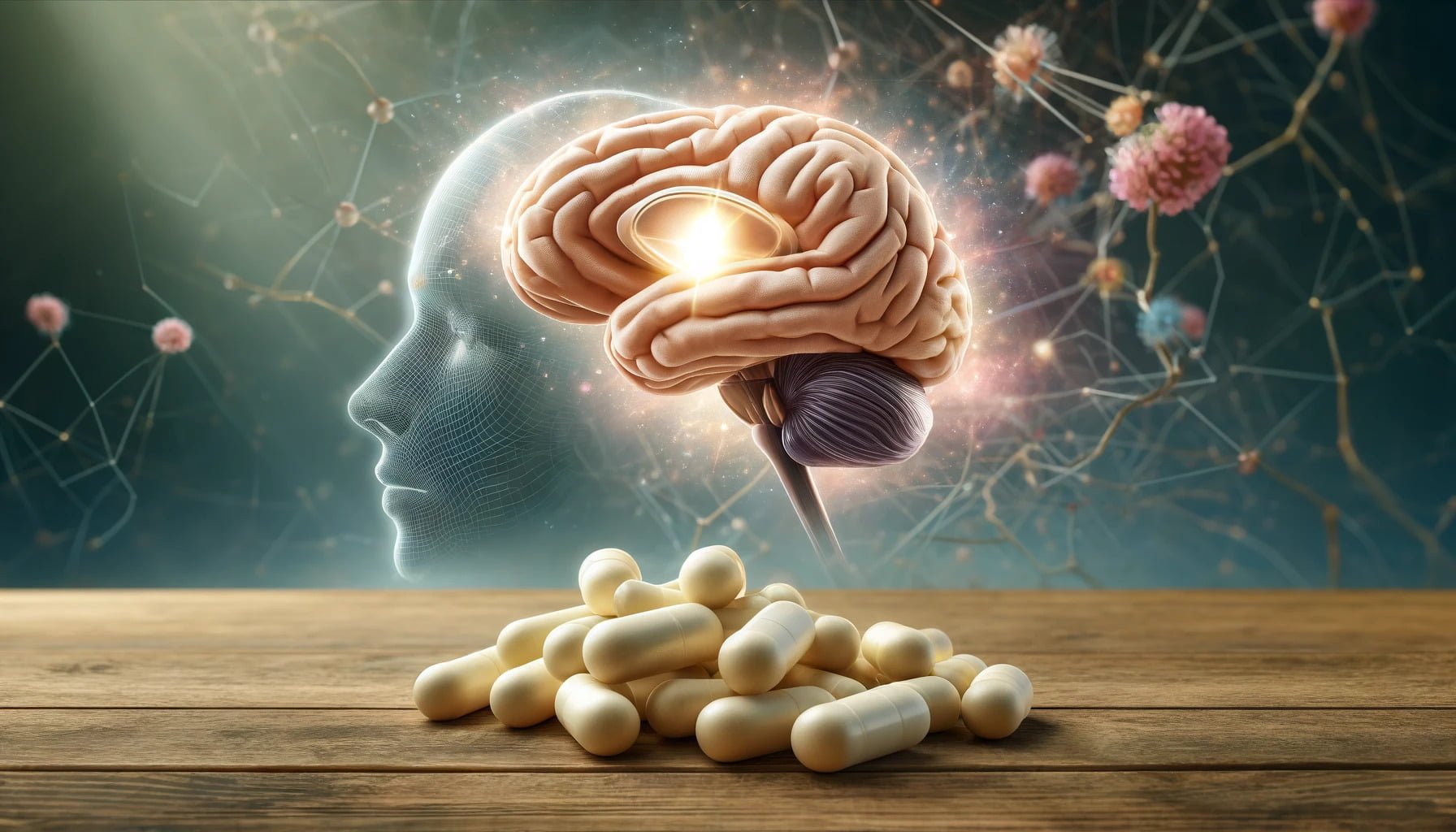
Vitamin B6 (pyridoxine) is a vital nutrient celebrated for its significant nootropic benefits.
Crucial for neurotransmitter synthesis, brain development, and mood regulation, Vitamin B6 has emerged as a key player in enhancing cognitive function, boosting mental clarity, and supporting emotional well-being.
In this article, we will look at the nootropic advantages of Vitamin B6, its diverse uses, recommended dosages, and potential side effects.
Table of Contents
What is Vitamin B6?
Vitamin B6 is one of the eight B-complex vitamins that are essential for proper brain function, metabolism, and overall health.

It’s a water-soluble vitamin, meaning that the body does not store it and it must be obtained through diet or supplementation.
Vitamin B6 is involved in over 100 enzymatic reactions in the body, many of which are crucial for cognitive health and performance.
What Are The Different Forms of Vitamin B6?
There are several different forms of Vitamin B6, each with slightly different functions and properties:
- Pyridoxine (PN): The most common supplemental form of Vitamin B6. It must be converted by the liver into the active form, pyridoxal 5′ phosphate (PLP).
- Pyridoxal (PL): The form of Vitamin B6 found in food. It’s also converted into PLP by the liver.
- Pyridoxal 5′ phosphate (PLP): The active coenzyme form of Vitamin B6 that is used in most enzymatic reactions in the body. It’s the most bioavailable form of Vitamin B6.
- Pyridoxamine (PM): Another form of Vitamin B6 found in food that is converted into PLP by the liver.
What Are The Functions of Vitamin B6 in the Brain and Body?
Vitamin B6 serves numerous essential functions in the brain and body:
- Neurotransmitter synthesis: PLP is a cofactor in the synthesis of several neurotransmitters, including serotonin, dopamine, GABA, and norepinephrine. These neurotransmitters regulate mood, cognition, sleep, and stress response.
- Amino acid metabolism: Vitamin B6 is involved in the metabolism of amino acids, which are the building blocks of proteins and neurotransmitters.
- Homocysteine regulation: Vitamin B6 helps regulate levels of homocysteine, an amino acid that can be neurotoxic in high concentrations.
- Neuroprotection: Vitamin B6 has antioxidant and anti-inflammatory properties that protect brain cells from oxidative stress and inflammation.
- Immune function: Vitamin B6 supports the production of white blood cells and antibodies, enhancing immune system function.
What Are The Dietary Sources of Vitamin B6?
Vitamin B6 is found in a variety of foods, including:
- Poultry, fish, and organ meats
- Potatoes and other starchy vegetables
- Fruit (other than citrus)
- Fortified cereals
- Beans and legumes
- Nuts and seeds
What is Vitamin B6’s Mechanism of Action?
Vitamin B6, in its active form pyridoxal 5′-phosphate (PLP), acts as a coenzyme in over 100 enzymatic reactions in the body. Its primary mechanism of action involves:
| Action | Mechanism |
|---|---|
| Neurotransmitter synthesis | PLP is a cofactor for enzymes involved in the synthesis of several neurotransmitters, including serotonin, dopamine, GABA, and norepinephrine. By supporting neurotransmitter production, Vitamin B6 helps regulate mood, cognition, sleep, and stress response. |
| Amino acid metabolism | PLP is essential for the metabolism of amino acids, which are the building blocks of proteins and neurotransmitters. It’s involved in transamination, deamination, and decarboxylation reactions that break down and convert amino acids. |
| Homocysteine regulation | Vitamin B6 helps regulate levels of homocysteine, an amino acid that can be neurotoxic in high concentrations. PLP is a cofactor for enzymes that convert homocysteine into other compounds, preventing its accumulation. |
| Neuroprotection | Vitamin B6 has antioxidant and anti-inflammatory properties that protect brain cells from oxidative stress and inflammation. It helps reduce the production of inflammatory cytokines and supports the synthesis of glutathione, a powerful antioxidant. |
How Does Vitamin B6 Affect the Brain?
Vitamin B6 plays a vital role in brain function and cognitive performance through its involvement in neurotransmitter synthesis.
It’s a cofactor in the production of several key neurotransmitters, including:
- Serotonin: Regulates mood, sleep, appetite, and pain perception
- Dopamine: Involved in reward, motivation, attention, and learning
- GABA: The main inhibitory neurotransmitter, helps reduce anxiety and promote relaxation
- Norepinephrine: Regulates alertness, arousal, and attention
How is Vitamin B6 Metabolized in The Body?
Vitamin B6 metabolism involves several steps:
- Absorption: Vitamin B6 is absorbed in the small intestine through passive diffusion. The different forms of Vitamin B6 (pyridoxine, pyridoxal, and pyridoxamine) are all converted into pyridoxal 5′-phosphate (PLP) in the liver.
- Transport: PLP is bound to albumin in the bloodstream and transported to tissues throughout the body. It can also be dephosphorylated back into pyridoxal and enter cells via membrane transporters.
- Enzymatic reactions: Inside cells, PLP acts as a coenzyme for numerous enzymatic reactions involved in neurotransmitter synthesis, amino acid metabolism, and other essential functions.
- Excretion: Excess Vitamin B6 is converted by the liver into pyridoxic acid, which is then excreted in urine. Because Vitamin B6 is water-soluble, the body does not store it in significant amounts, and it must be regularly obtained through diet or supplementation.
How Bioavailable is Vitamin B6?
The bioavailability of Vitamin B6 varies depending on the form consumed:
| Form | Bioavailability |
|---|---|
| Pyridoxine (PN) | Around 95% when taken orally |
| Pyridoxal (PL) and Pyridoxamine (PM) | Around 75% due to their need for conversion into PLP by the liver |
| Pyridoxal 5′-phosphate (PLP) | Has the highest bioavailability, as it does not require conversion by the liver. However, PLP supplements are less stable and more expensive than other forms |
Factors that can affect Vitamin B6 bioavailability include:
- Digestive health and absorption capacity
- Liver function and conversion efficiency
- Interactions with medications or other supplements
- Older adults may have reduced absorption and conversion of Vitamin B6
What Are The Cognitive Benefits of Vitamin B6?
Vitamin B6 offers several cognitive benefits, primarily because of its role in neurotransmitter synthesis and regulation:
- Improved mood
- Enhanced memory and learning
- Reduced cognitive decline
- Better sleep quality

How Does Vitamin B6 Improve Mood?
Vitamin B6 improves mood by supporting the production of serotonin, a neurotransmitter that regulates emotions, appetite, and sleep. A deficiency in Vitamin B6 can lead to decreased serotonin levels, which may result in depression, irritability, and mood swings.
A double-blind crossover trial from 2023 found that Vitamin B6 supplementation at 100 mg/day for 4 weeks significantly improved mood and reduced depression symptoms in women using contraceptives.(1)
How Does Vitamin B6 Enhance Memory and Learning?
Vitamin B6 enhances memory and learning by supporting the synthesis of acetylcholine, a neurotransmitter essential for cognitive function.
It also plays a role in the metabolism of homocysteine, an amino acid that, when elevated, can impair memory and increase the risk of cognitive decline.
A study from 2013 demonstrated that Vitamin B6 supplementation at 20 mg/day for 3 months improved memory performance in older adults.(2)
How Does Vitamin B6 Reduce Cognitive Decline?
Vitamin B6 reduces cognitive decline by maintaining healthy homocysteine levels and supporting the integrity of brain cells.
High homocysteine levels have been associated with an increased risk of Alzheimer’s disease and other forms of dementia.
According to a randomized controlled trial from 2010, Vitamin B6 supplementation, along with vitamin B12 and folate, can significantly reduce homocysteine levels and slow cognitive decline in older adults.(3)
What Are The Side Effects and Risks Associated with Vitamin B6 Supplementation?
Vitamin B6 is safe and well-tolerated when consumed in recommended doses.
However, high doses of Vitamin B6, particularly from supplements, can cause adverse effects:
- Sensory neuropathy: Long-term use of high-dose Vitamin B6 supplements (>1,000 mg per day) can cause sensory neuropathy, characterized by numbness and tingling in the hands and feet. This effect is usually reversible upon the discontinuation of the supplement.
- Gastrointestinal distress: High doses of Vitamin B6 can cause nausea, vomiting, abdominal pain, and diarrhea.
- Skin reactions: Some people may experience skin rashes or acne-like lesions with high-dose Vitamin B6 supplementation.
Who Should Avoid Using Vitamin B6 as A Nootropic?
While Vitamin B6 is safe for most people, some individuals should avoid using it as a nootropic supplement:
- People with sensory neuropathy: If you have pre-existing sensory neuropathy or are at risk for developing it (e.g., due to diabetes or alcohol abuse), high-dose Vitamin B6 supplementation may exacerbate the condition.
- Pregnant or breastfeeding women: While Vitamin B6 is important for fetal development, pregnant and breastfeeding women should not exceed the recommended daily intake (1.9 mg for pregnant women and 2.0 mg for lactating women) without medical supervision.
- People with a rare genetic disorder called pyridoxine-dependent epilepsy: This condition is characterized by seizures that are responsive to high doses of Vitamin B6. These individuals should only take Vitamin B6 under medical supervision.
Are There Any Known Medical Interactions With Vitamin B6?
Yes, Vitamin B6 can interact with several medications:
- Antidepressants: Vitamin B6 can interact with certain antidepressants, particularly monoamine oxidase inhibitors (MAOIs) and selective serotonin reuptake inhibitors (SSRIs). High doses of Vitamin B6 may enhance the effects of these medications, potentially leading to serotonin syndrome.
- Anticonvulsants: Some anticonvulsant medications, such as phenytoin and phenobarbital, can reduce Vitamin B6 levels in the body. Conversely, high doses of Vitamin B6 may decrease the effectiveness of these medications.
- Chemotherapy drugs: Vitamin B6 may reduce the efficacy of certain chemotherapy drugs, such as altretamine and cisplatin. It’s important for cancer patients to consult their oncologist before taking any supplements.
- Levodopa: Vitamin B6 can reduce the effectiveness of levodopa, a medication used to treat Parkinson’s disease. If you are taking levodopa, your doctor may recommend avoiding Vitamin B6 supplements.
- Theophylline: High doses of Vitamin B6 can decrease the absorption and effectiveness of theophylline, a medication used to treat asthma and chronic obstructive pulmonary disease (COPD).
- Antibiotics: Some antibiotics, such as cycloserine and isoniazid, may increase the risk of Vitamin B6 deficiency.
- Oral contraceptives: Long-term use of oral contraceptives can lower Vitamin B6 levels in the body.
Note: It’s crucial to inform your healthcare provider about all the supplements and medications you are taking to avoid potential interactions.
How To Use Vitamin B6 as A Nootropic?

To use Vitamin B6 as a nootropic, consider the following guidelines:
- Choose the right form: Pyridoxal 5′-phosphate (PLP) is the most bioavailable form of Vitamin B6, but it’s also more expensive and less stable than other forms. Pyridoxine hydrochloride is a common and affordable form used in many supplements.
- Start with a low dose: The recommended daily intake (RDI) of Vitamin B6 for adults is 1.3 mg. For nootropic purposes, start with a dose of 10-25 mg per day and assess your tolerance and response before increasing the dosage.
- Take with food: Vitamin B6 is best absorbed when taken with a meal, particularly one that contains protein and other B vitamins.
- Consider combining with other nootropics: Vitamin B6 works well in combination with other nootropics, such as caffeine, L-theanine, and racetams. It may enhance the cognitive benefits of these substances and reduce potential side effects.
- Monitor for side effects: While Vitamin B6 is generally safe and well-tolerated, high doses can cause side effects such as sensory neuropathy, gastrointestinal distress, and skin reactions. If you experience any adverse effects, discontinue use and consult a healthcare provider.
- Cycle your use: To avoid building tolerance and potential side effects, consider cycling your Vitamin B6 supplementation. For example, you could take it for 4-6 weeks, followed by a 1-2 week break before resuming use.
What is The Recommended Dosage of Vitamin B6?
The recommended daily allowance (RDA) for Vitamin B6 varies by age and gender:
| Age | Recommended Daily Allowance (RDA) |
|---|---|
| Adults (19-50 years) | 1.3 mg/day |
| Adults (51+ years) | 1.7 mg/day for men, 1.5 mg/day for women |
| Pregnant women | 1.9 mg/day |
| Lactating women | 2.0 mg/day |
Vitamin B6 dosage safety:
- RDA: 1.3-1.7 mg/day for adults
- Nootropic doses: 10-100 mg/day
- Upper safe limit: 100 mg/day
However, it’s important to consult with a healthcare professional before taking high doses of Vitamin B6, as excessive intake can lead to nerve damage.
Note: Do not exceed 100 mg per day without the guidance of a healthcare professional.
Can Vitamin B6 Be Used in A Nootropic Stack?
Vitamin B6 can be effectively combined with other nootropics to create a synergistic cognitive-enhancing stack. Some popular nootropics that pair well with Vitamin B6 include:
- Citicoline: Provides choline for acetylcholine synthesis and supports brain cell membrane health. Vitamin B6 enhances the conversion of choline to acetylcholine).
- Bacopa monnieri: An herb that improves memory and reduces anxiety. Vitamin B6 may enhance the effects of bacopa by supporting neurotransmitter synthesis.
- L-Theanine: An amino acid found in green tea that promotes relaxation and reduces stress. Vitamin B6 may potentiate the calming effects of L-theanine by supporting GABA production.
- Omega-3 fatty acids: Essential fats that support brain health and cognitive function. Vitamin B6 may enhance the neuroprotective effects of omega-3s by reducing inflammation and oxidative stress.
- C Curtin, Anne, and Carol S Johnston. “Vitamin B6 Supplementation Reduces Symptoms of Depression in College Women Taking Oral Contraceptives: A Randomized, Double-Blind Crossover Trial.” Journal of dietary supplements vol. 20,4 (2023): 550-562. doi:10.1080/19390211.2022.2030843↩
- Reay, J L et al. “B vitamins and cognitive performance in older adults: review.” ISRN nutrition vol. 2013 650983. 11 Mar. 2013, doi:10.5402/2013/650983↩
- Smith, A David et al. “Homocysteine-lowering by B vitamins slows the rate of accelerated brain atrophy in mild cognitive impairment: a randomized controlled trial.” PloS one vol. 5,9 e12244. 8 Sep. 2010, doi:10.1371/journal.pone.0012244↩
